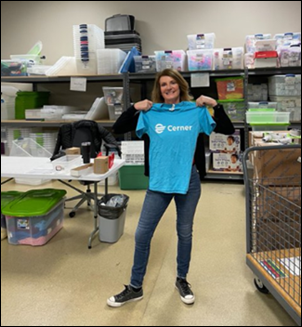News 12/14/22
Top News
![]()
Oracle reports Q2 2023 results: revenue up 18%, EPS $1.21 vs. $1.18, beating Wall Street expectations for both.
Oracle’s Cerner unit contributed $1.5 billion to the company’s quarterly sales of $12.3 billion.
Oracle shares have seen a 33% increase since October 1. It acquired Cerner in June for $28 billion.
From the earnings call:
-
Total revenue grew 9% even without Cerner’s contribution.
-
Cloud revenue was up 48% including Cerner and 25% without.
-
CEO Safra Catz says that five months post-acquisition, Cerner is performing better than Oracle projected.
-
CTO and chairman Larry Ellison said that while Cerner and Epic mostly automated hospitals, Oracle wants “to do national public health.” He added that several countries will be signing contracts with Oracle to build national healthcare early warning systems, concluding that “we, as humanity, have to do a better job of delivering healthcare to people than we have done historically.”
Webinars
None scheduled soon. Previous webinars are on our YouTube channel. Contact Lorre to present your own.
Sales
- ACO Triad HealthCare Network (NC) selects DrFirst’s MedHx Population Risk Management software, which provides fast access to prescription fulfillment data.
- Mississippi’s Division of Medicaid and Department of Human Services will implement Verato’s Universal Identity data management technology.
People

Consumer goods manufacturer Newell Brands hires Mark Erceg (Oracle Cerner) as CFO.
Announcements and Implementations
US News & World Report is evaluating 3M Ambulatory Potentially Preventable Complications software for potential use in its “Best Hospitals” rankings.
Mount Sinai Health System (NY) begins offering on-site telemedicine services to patients who call 911 and meet certain low-acuity criteria. The new service is part of a five-year federal pilot program that aims to divert non-critical 911 patients from emergency rooms to more appropriate sites of care that will eventually include urgent care and behavioral health facilities.

OSF Healthcare’s OnCall Digital Health unit launches a remote patient monitoring service for pediatric RSV patients, giving at-home caregivers the ability to access educational materials and report symptoms over a 10-day period using a companion app. OSF offers similar RPM programs for patients with diabetes and heart failure.
Government and Politics

DHA Tidewater Market facilities in Virginia including Naval Medical Center Portsmouth, Air Force 633 Medical Group, and McDonald Army Health Center prepare to implement MHS Genesis, an Oracle Cerner system, next month.
Privacy and Security
Stat continues the efforts of The Markup to identify websites that use the Meta Pixel to collect visitor information and send it to Facebook. Analysis found that of 50 direct-to-consumer telehealth sites, 35 shared personal information and 13 sent answers to potentially sensitive user questionnaires. Thirty of the 50 sites used at least one social media tracking tool to collect the answers to medical intake questions. Amazon Clinic was the only one of the 50 sites that doesn’t send URLs and IP addresses to outside companies. The worst offender was Cerebral, which provided information to all seven major trackers (Google, Facebook, Bing, TikTok, Snapchat, Pinterest, and LinkedIn).

One Brooklyn Health continues to bring systems back online at its three hospitals after a November 19 cybersecurity incident. The downtime has forced staff to chart and carry paper records by hand to individual units, and has slowed lab results and the analysis of diagnostic imaging, which can no longer be done in-house.
Other

A Current Health survey of 100 hospital leaders finds that reducing readmissions, hospitalizations, and ER visits are top reasons for launching care-at-home programs. While 66% of respondents have launched some type of care-at-home program, staffing challenges and a lack of patient engagement and in-home technology support have sometimes hampered their effectiveness. Clinical monitoring support, logistics support, and in-home technical support are top considerations for organizations that are considering launching or enhancing such programs.
Sponsor Updates
- Ascom Americas hires Joe Mahloch as project manager, professional services group.
- CB Insights names Availity a top digital health company in its “Digital Health 150” report.
- Baker Tilly publishes a new case study, “Health system identifies more than $150 million of revenue opportunities through service line and managed care contracting assessment.”
- Nordic publishes a new video in its “The Download” series titled “Chronic disease management done differently.”
- ACHE Middle Tennessee names CereCore Client Services Manager Jessica Zayakosky treasurer-elect.
- Cerner co-sponsors the Bear Institute Pediatric Accelerator Challenge for Kids awards ceremony and closing event.
- CHIME submits comments to CMS in response to its RFI on its proposed National Directory of Healthcare Providers & Services, noting that such a directory “must truly reduce reporting burdens for healthcare providers.”
- Luxiere Magazine profiles Cordea Consulting founder and CEO Jen Jones.
- CloudWave will sponsor the MUSE Ohio – Community Peer Group Event December 14 in Wooster.
- Dimensional Insight expands its work with Puerto Rico-based health IT consulting firm Trinexus to include healthcare facilities in the Caribbean.
- Frost & Sullivan recognizes Meditech with the 2022 North America Enabling Technology Leadership Award.
Blog Posts
- 30 years of UpToDate: The evolution of clinical decision support and the future of evidence-based medicine (Wolters Kluwer Health)
- What You Need to Know About CMS’ New Proposal: Advancing Interoperability and Improving Prior Authorization Processes (Diameter Health)
- How to reduce emergency room visits this winter (Arcadia)
- Value-based Care & Intelligent Care Management (CarePort Health)
- Practice Management Optimization through EHR Software (ChartLogic)
- 10 Myths About Running a Medicare Chronic Care Management Program (ChartSpan)
- Data Governance is NOT a Dirty Word, It’s Asset Management (Part 2) (Clearsense)
- Talking Cyber Resilience and Business Risk to Your Board and Executives (Clearwater)
- Top 2 Challenges Providers Face When Implementing HCC (CTG)
- Healthcare Applications Dashboards: Patterns for Exposing Data (Dimensional Insight)
- CHIME 2022 Conference Recap and Takeaways (Divurgent)
Contacts
Mr. H, Lorre, Jenn, Dr. Jayne.
Get HIStalk updates.
Send news or rumors.
Contact us.

































































































































Merry Christmas and a Happy New Year to the HIStalk crowd. I wish you the joys of the season!